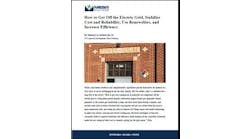In Australia, New South Wales’ grid operator goes against the convention and pursues a microgrid
Plans to power the remote New South Wales mining city of Broken Hill with a world-first renewable microgrid have been revived after transmission company Transgrid found a way to dump the diesel option that it was being forced to adopt by Australia’s archaic energy rules and regulations.
The renewable microgrid proposal is based around using – for the first time ever at such scale – a 200 MW, 1,500 MWh storage facility using compressed air technology developed by Canadian company Hydrostor.
Those plans, first announced in 2020, were set to be dumped last year when Transgrid was forced instead to choose the installation of new diesel turbines because Australia’s National Electricity Market rules allow no consideration of environmental benefits.
In a strict definition of economic benefits, the highly polluting diesel generators won out over the cleaner energy storage option, but Transgrid and Hydrostor and its project partner Energy Estate have now revisited the plan and – helped by an anticipated grant from the Australian Renewable Energy Agency (ARENA) – believe it wins out over the dirty diesel option.
It’s a bold play by Transgrid. Historically, networks are not known for [gambling] on new technologies over traditional poles and wires and other conventional options – partly because of the old-fashioned rules that govern the market and discourage innovation.
But Transgrid insists there is little risk to it or consumers because the nature of the deal with Hydrostor means that the Canadian company and its partner won’t get paid if they can’t deliver the project. Hydrostor has “proven” the technology at pilot scale but not yet rolled it out at commercial scale.
“We like non-network solutions,” Transgrid’s head of delivery, Craig Stallan, told RenewEconomy, adding that Transgrid will nevertheless “upgrade” two existing diesel generators at Broken Hill, at minimal cost, just in case.
“We only pay if it works, we only pay [Hydrostor] if that service is provided,” added Marie Jordan, Transgrid’s newly appointed head of network.
The decision to go with Hydrostor – if approved by the Australian Energy Regulator – will turn Broken Hill into a hotbed of edge-of-grid innovation, combing compressed air storage with the existing 200-MW Silverton wind farm, the 50-MW Broken Hill solar farm, and the newly committed 50MW/50MWh Broken Hill battery.
The region has had more wind and solar generation than it knows what to do with and has often struggled to export the full output of those facilities to the rest of the grid, resulting in heavy curtailment of the local wind and solar farms.
The addition of the shorter term battery and the longer term compressed air storage will maximize the renewables output, provide more resilience to the local grid and provide a ready supply of plentiful cheap, clean and reliable green energy for the mining and minerals processing industries that are expected to revive the local economy.
The latest project assessment estimates $268 million of economic benefits from the Hydrostor option, which Transgrid says is a 5% better return than installing two new 25-MW diesel generators, and Transgrid notes new investment in fossil fuels is less desirable given the green energy transition happening elsewhere.
The “economic advantage” is, however, dependent on ARENA agreeing to a grant. The size of the requested grant has not been revealed, given it has not been agreed, but the document suggests at least $13.2 million will be needed to keep the storage option ahead. If the grant is not forthcoming, it will be back to the diesels.
Hydrostor plans to install the compressed air storage facility in an old mining operation, using abandoned caverns to store the compressed air, which is released when needed to spin turbines and generate power.
Hydrostor describes its technology as a “giant air battery.” It uses off-peak renewable electricity to run a compressor that produces heated, compressed air, which is then stored in underground caverns. When needed, the compressed air is expanded through a turbine to generate electricity.
“Transgrid understands the value offered by our A-CAES solution, and we are very pleased to have been selected as the preferred alternative over competing proposals,” said Hydrostor CEO Curtis Van Walleghem
“New South Wales is a global leader with its clean energy policy and net-zero ambitions and we are looking forward to commencing our first A-CAES project in Australia.”
Transgrid’s Jordan says the decision is in the long-term interests of consumers.
“Hydrostor is proposing an exciting technology which would establish a minigrid using compressed air storage in a disused mine, in conjunction with existing local wind and solar generation,” she said in a statement. “This initiative would represent an Australian first and the scale of it is impressive. As one of the largest renewable minigrids to be created worldwide, we’d expect it to secure supply for Broken Hill and create at least 260 construction jobs and a further 70 ongoing roles after project completion.”







